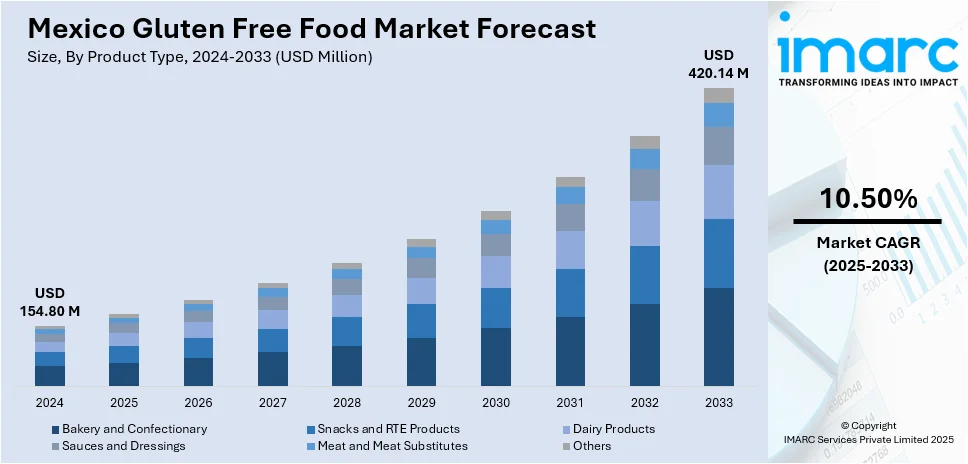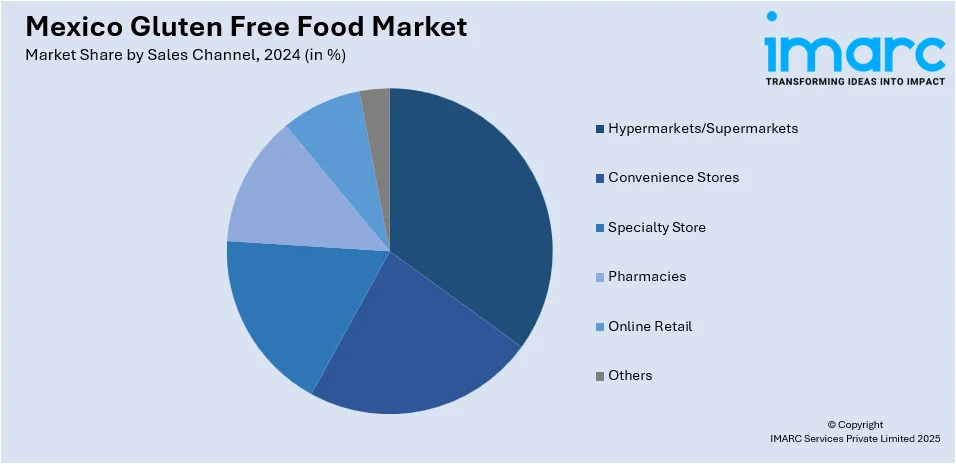
Mexico Gluten Free Food Market Size, Share, Trends and Forecast by Product Type, Source, Sales Channel, and Region, 2025-2033
Mexico Gluten Free Food Market Overview:
The Mexico gluten free food market size reached USD 154.80 Million in 2024. Looking forward, IMARC Group expects the market to reach USD 420.14 Million by 2033, exhibiting a growth rate (CAGR) of 10.50% during 2025-2033. At present, with an increasing number of people becoming aware about the symptoms and health hazards linked to gluten intake, particularly for individuals with celiac disease, the need for gluten-free alternatives is growing. Besides this, the broadening of retail channels, which aids in enhancing the visibility and accessibility of products, is contributing to the expansion of the Mexico gluten free food market share.
|
Report Attribute
|
Key Statistics
|
|---|---|
|
Base Year
|
2024
|
|
Forecast Years
|
2025-2033
|
|
Historical Years
|
2019-2024
|
| Market Size in 2024 | USD 154.80 Million |
| Market Forecast in 2033 | USD 420.14 Million |
| Market Growth Rate 2025-2033 | 10.50% |
Mexico Gluten Free Food Market Trends:
Rising awareness about gluten intolerance and celiac disease
The increasing awareness about gluten intolerance and celiac disease is positively influencing the market. As more people are learning about the symptoms and health risks associated with gluten consumption, particularly for those with celiac disease, the demand for gluten-free options continues to rise. As per the findings of research conducted in the northwest of Mexico, as of October 2024, a total of 83% of the patients improved with a gluten-free diet. Healthcare professionals increasingly diagnose gluten-related disorders, encouraging people to seek dietary solutions. Educational campaigns and social media portals are also significantly contributing to disseminating information about the benefits of gluten-free diets. As people are becoming more informed, they are actively looking for gluten-free labels and making conscious purchasing decisions. Food manufacturers are responding to this trend by offering a wider variety of gluten-free products, ranging from snacks to bakery items and meal kits. Restaurants and cafes are also adapting their menus to include gluten-free options, making dining out more inclusive. This growing awareness is fostering a supportive environment for individuals managing gluten sensitivity. It is also motivating those without medical gluten intolerance to choose gluten-free foods as part of a perceived healthier lifestyle.

Expansion of retail outlets
The broadening of retail channels is impelling the Mexico gluten free food market growth. According to DENUE 2024, retail trade recorded 2,514,611 economic units in the country. The states with the largest quantity of economic units were Estado de México (396,325), Ciudad de México (207,183), and Puebla (178,716). Supermarkets, hypermarkets, and convenience stores are expanding their presence in urban and semi-urban areas, offering dedicated sections for health-conscious and dietary-specific products. This helps people easily find gluten-free options without visiting specialty stores. Online retail platforms are also growing rapidly, providing a wide range of gluten-free food products with home delivery, making it convenient for people in remote areas to access these items. Retailers are investing in better product placement, clear labeling, and promotional campaigns to attract health-focused buyers. They are also collaborating with gluten-free brands to launch private label products, making gluten-free choices more affordable. As retail channels are rising in number, the competition is increasing, which is improving product quality and pricing. People benefit from a greater variety of gluten-free food items, including snacks and ready-to-eat (RTE) meals. This growing retail footprint is supporting user awareness and encouraging trial, ultimately driving the demand.
Mexico Gluten Free Food Market Segmentation:
IMARC Group provides an analysis of the key trends in each segment of the market, along with forecasts at the country and regional levels for 2025-2033. Our report has categorized the market based on product type, source, and sales channel.
Product Type Insights:
- Bakery and Confectionary
- Snacks and RTE Products
- Dairy Products
- Sauces and Dressings
- Meat and Meat Substitutes
- Others
The report has provided a detailed breakup and analysis of the market based on the product type. This includes bakery and confectionary, snacks and RTE products, dairy products, sauces and dressings, meat and meat substitutes, and others.
Source Insights:
- Plant-Based
- Animal-Based
A detailed breakup and analysis of the market based on the source have also been provided in the report. This includes plant-based and animal-based.
Sales Channel Insights:

- Hypermarkets/Supermarkets
- Convenience Stores
- Specialty Store
- Pharmacies
- Online Retail
- Others
The report has provided a detailed breakup and analysis of the market based on the sales channel. This includes hypermarkets/supermarkets, convenience stores, specialty store, pharmacies, online retail, and others.
Regional Insights:
- Northern Mexico
- Central Mexico
- Southern Mexico
- Others
The report has also provided a comprehensive analysis of all the major regional markets, which include Northern Mexico, Central Mexico, Southern Mexico, and others.
Competitive Landscape:
The market research report has also provided a comprehensive analysis of the competitive landscape. Competitive analysis such as market structure, key player positioning, top winning strategies, competitive dashboard, and company evaluation quadrant has been covered in the report. Also, detailed profiles of all major companies have been provided.
Mexico Gluten Free Food Market News:
- In February 2024, the BRCGS Global Standard for Gluten-Free, Issue 4, was released. It offered an enhanced and resilient standard that would provide increased assurance and value to all parties involved. The strictness of BRCGS Gluten-free certification gained the approval of a wide range of national and regional associations in the USA, Canada, and Mexico. This enabled certified sites to utilize the on-pack association trademarks that had the greatest consumer recognition in their market, including the Acelmex gluten-free trademark in Mexico and Latin America.
- In February 2024, Grupo Bimbo SAB de CV, based in Mexico, purchased Amaritta Food SL, a firm dedicated to the research and production of gluten-free bread. This acquisition allowed the firm to keep getting expertise in this category while leveraging new technology to take advantage of the growth opportunities in the high-potential market.
Mexico Gluten Free Food Market Report Coverage:
| Report Features | Details |
|---|---|
| Base Year of the Analysis | 2024 |
| Historical Period | 2019-2024 |
| Forecast Period | 2025-2033 |
| Units | Million USD |
| Scope of the Report |
Exploration of Historical Trends and Market Outlook, Industry Catalysts and Challenges, Segment-Wise Historical and Future Market Assessment:
|
| Product Types Covered | Bakery and Confectionary, Snacks and RTE Products, Dairy Products, Sauces and Dressings, Meat and Meat Substitutes, Others |
| Sources Covered | Plant-Based, Animal-Based |
| Sales Channels Covered | Hypermarkets/Supermarkets, Convenience Stores, Specialty Store, Pharmacies, Online Retail, Others |
| Regions Covered | Northern Mexico, Central Mexico, Southern Mexico, Others |
| Customization Scope | 10% Free Customization |
| Post-Sale Analyst Support | 10-12 Weeks |
| Delivery Format | PDF and Excel through Email (We can also provide the editable version of the report in PPT/Word format on special request) |
Key Questions Answered in This Report:
- How has the Mexico gluten free food market performed so far and how will it perform in the coming years?
- What is the breakup of the Mexico gluten free food market on the basis of product type?
- What is the breakup of the Mexico gluten free food market on the basis of source?
- What is the breakup of the Mexico gluten free food market on the basis of sales channel?
- What is the breakup of the Mexico gluten free food market on the basis of region?
- What are the various stages in the value chain of the Mexico gluten free food market?
- What are the key driving factors and challenges in the Mexico gluten free food market?
- What is the structure of the Mexico gluten free food market and who are the key players?
- What is the degree of competition in the Mexico gluten free food market?
Key Benefits for Stakeholders:
- IMARC’s industry report offers a comprehensive quantitative analysis of various market segments, historical and current market trends, market forecasts, and dynamics of the Mexico gluten free food market from 2019-2033.
- The research report provides the latest information on the market drivers, challenges, and opportunities in the Mexico gluten free food market.
- Porter's five forces analysis assist stakeholders in assessing the impact of new entrants, competitive rivalry, supplier power, buyer power, and the threat of substitution. It helps stakeholders to analyze the level of competition within the Mexico gluten free food industry and its attractiveness.
- Competitive landscape allows stakeholders to understand their competitive environment and provides an insight into the current positions of key players in the market.
Need more help?
- Speak to our experienced analysts for insights on the current market scenarios.
- Include additional segments and countries to customize the report as per your requirement.
- Gain an unparalleled competitive advantage in your domain by understanding how to utilize the report and positively impacting your operations and revenue.
- For further assistance, please connect with our analysts.
 Request Customization
Request Customization
 Speak to an Analyst
Speak to an Analyst
 Request Brochure
Request Brochure
 Inquire Before Buying
Inquire Before Buying




.webp)




.webp)












